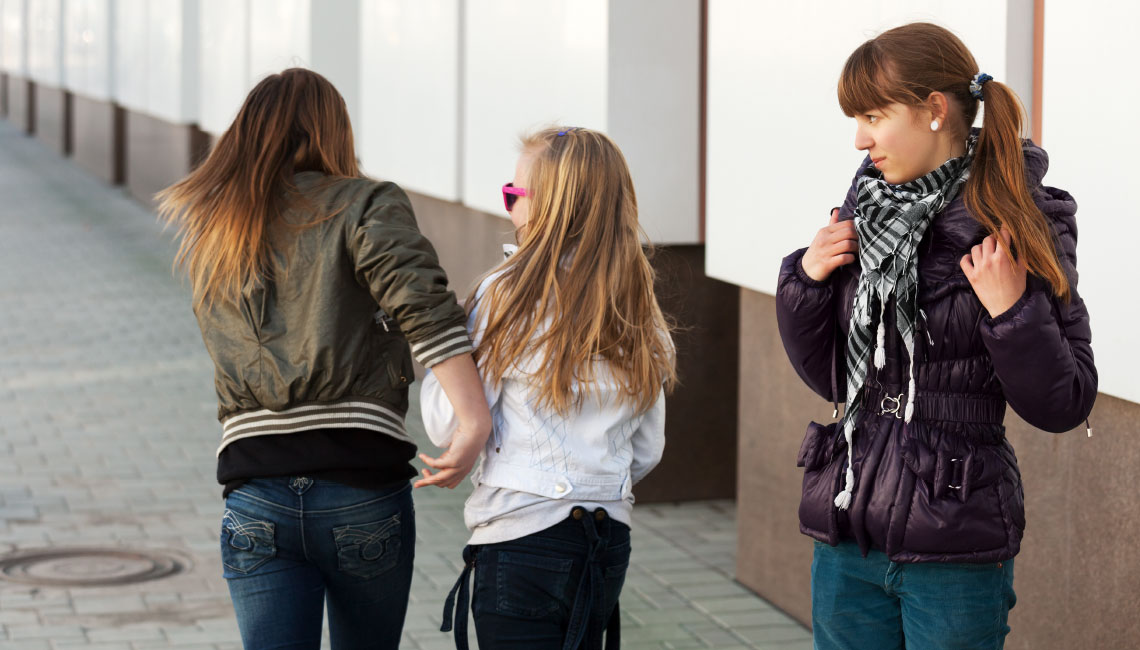Being friends with two people who don’t get along or with one who bullies another can be tough. This can be especially difficult for kids and teens. A child may become friends with someone who their existing friend doesn’t like. Or, a child may get stuck in the middle of two friends who used to get along, but now don’t. When these scenarios happen, the person stuck in the middle may feel like they’re forced to lie or choose a side in order to prevent having one or both of their friends turn against them.
While it would definitely be easier if there were no issues and everyone got along, it is possible to maintain friendships with two people that don’t happily coexist.
When one friend is bullying another friend
When you witness one friend bullying another, you become a bystander. Below, is an example of a bully, victim and bystander among three friends.
Several days during lunch, Molly has been making fun of Tina. It’s evident that these jabs are more than just teasing and that they’re making Molly feel bad. Natasha, who is friends with both of them, is not sure what to do.
A bystander, especially when it’s among friends, can feel very uncomfortable. You may want to speak up, but don’t know how. You may feel bad for one friend, but afraid to say something to the other friend.
The power of peer influence is huge and can scare many people away from doing the right thing. It takes a great deal of courage and strength to stand up to one or more peers who are being bullies. While it’s good if you feel comfortable being a positive bystander, more often than not, most people (especially kids) are neutral bystanders. They don’t take a side one way or another – with the victim or the bully. There are many reasons why most people don’t get involved, including fear of being bullied themselves and losing a friend.
It’s important to know that if you’re a neutral bystander during the bullying, your voice and actions can still be powerful afterwards.
Below, are some ways a neutral bystander can remain friends with the bully and the victim and still have a powerful voice.
- Go back to the friend after the bullying and ask if she is ok.
- Stay kind. Don’t go along with the bully’s negative comments and remain positive to both friends.
- During the bullying, try to change the subject. Veer away from making or agreeing with negative comments.
- While standing up for another kid is great, parents should not push their kids to do so. Instead, they can teach their kids to use empathy, empowerment and engagement and help their kids practice being a bystander with a positive voice, or friends with two people who don’t get along by role playing.
Staying neutral in friends’ battles
When you have two friends that have turned against each other, one of the best things that you can do is to be there for both of them. Staying neutral means not picking sides or saying bad things about one to the other. It’s best to state your feelings openly and honestly, which means telling both of your friends that you care about them and value their friendship. If your two friends refuse to hang out together, it’s important to let both know that you respect their decisions, yet you would like to remain friends with both.
Staying neutral may seem more difficult for kids and teens in school, but it can still be done. For example, if there’s a group of three kids who used to eat lunch together, but now two of the friends have split ways, you can let your friends know that you want to maintain friends with both of them. The neutral friend can try taking turns having lunch with the two friends in conflict. There may be times; however, when it’s not possible to divide your time. For an example, if you’re having a party or planning to do something that you know both of your friends would enjoy and you don’t want to pick one friend over another, you might consider extending an invitation to both and letting them know that they’ve both been invited.
Bottom line
You should never choose sides or drop a friend because you feel pressured to do so. A true friend should not ask or expect you to do that. Be true to yourself and honest with others. Sometimes, despite trying your best to maintain friendships with two people who don’t get along, you may end up realizing that your own relationship with one or both friends has been impacted. For example, if one of your friends has repeatedly shown that she doesn’t respect your decision to be friends with both or is trying to force you to choose sides, you may need to take time to evaluate that friendship.
About the Author:
Danielle Matthew is a Licensed Marriage and Family Therapist who treats bully victims and their families and educates schools, medical professionals and the community about the bullying epidemic. With over 20 years of experience, Danielle authored Amazon Parenting Best-Seller, The Empowered Child: How to Help Your Child Cope, Communicate, and Conquer Bullying, and is the Director of The Empowerment Space Bullying Therapy Program in Los Angeles. Featured in Huffington Post and TODAY.com, Danielle has appeared on Fox, ABC and CBS Morning Shows and Mom Talk Radio, and is the expert contributor to Washington Post’s article: “Kids love to ‘roast’ each other. But when does good-natured teasing become bullying?”
Please click here if you’d like to schedule a consultation with Danielle.




